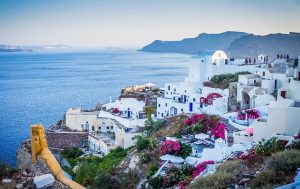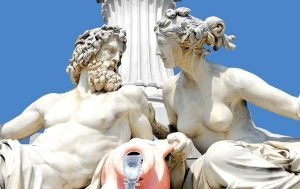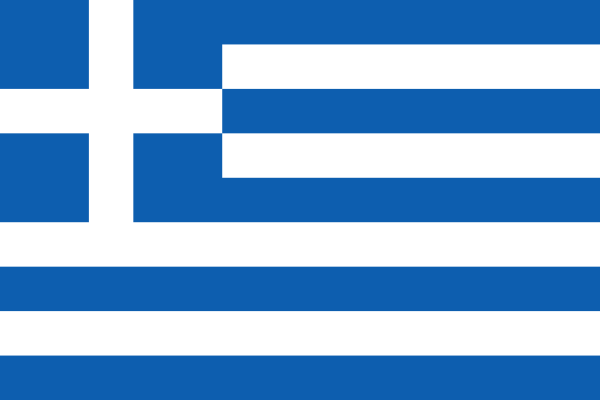Introduction to Greek Week
Over the next two weeks you are going to be learning about Greece, both modern and ancient. Each day you will complete one session. At the end of week one you will be rewarded with by eating out at a Greek restaurant. By the end of week two you will be a Greece proficianado.
Note: Please use Chrome browser as this is better for Google Earth.
Session 1
A Virtual Exploration of Greece
About Greece
Greece is officially called the Hellenic Republic. It was historically also known as Hellas. Greece is a country in Southern Europe with a population of approximately 11 million as of 2016. Athens is the nation’s capital and largest city, followed by Thessaloniki.
Take a Quick Tour of Athens.
Greece is located at the crossroads of Europe, Asia, and Africa. It shares land borders with Albania to the northwest, the Republic of Macedonia and Bulgaria to the north, and Turkey to the northeast. The Aegean Sea lies to the east of the mainland, the Ionian Sea to the west, the Cretan Sea and the Mediterranean Sea to the south.
Label a Map of Greece (booklet)
Greece has the longest coastline on the Mediterranean Basin and the 11th longest coastline in the world at 13,676 km (8,498 mi) in length.
Greece has a large number of islands, of which 227 are inhabited.
Eighty percent of Greece is mountainous, with Mount Olympus being the highest peak at 2,918 metres (9,573 ft).
The country consists of nine geographic regions: Macedonia, Central Greece, the Peloponnese, Thessaly, Epirus, the Aegean Islands (including the Dodecanese and Cyclades), Thrace, Crete, and the Ionian Islands.
Greece is considered the cradle of Western civilization. It is the birthplace of democracy, Western philosophy, the Olympic Games and Western literature and drama to mention a few.
Google Earth
Quick tour of Greece Landmarks
Virtual Greece
Greece Virtual 3D panoramas and sounds.
Greek Web Cams
End of Session Quiz
Virtual Greece – Quick Geography Quiz
How much do you know about the basic Geography of Greece?

Session 2
Greek Language
Greek Alphabet
The Greek alphabet has been used to write the Greek language since the late 9th century BC or early 8th century BC. It was derived from the earlier Phoenician alphabet, and was the first alphabetic script to have distinct letters for vowels as well as consonants.
Today, the Greek alphabet today also serves as a source of technical symbols and labels in many domains of mathematics, science and other fields.
The alphabet has 24 letters, ordered from alpha to omega.
Greek Alphabet Chart (booklet)
Greek Alphabet Poster (booklet)
Greek upper-lower case letter match quiz.
Speak Greek
Greek has the longest documented history of any living Indo-European language, spanning 34 centuries (3,400 years) of written records.
The Greek language holds an important place in the history such as the epic poems Iliad and Odyssey. Greek is also the language in of many of the foundational texts in science, especially astronomy, mathematics and logic.
The New Testament of the Christian Bible was written in Greek.
Session 3
Greek Food
The most characteristic and ancient element of Greek cuisine is olive oil, which is used in most dishes. It is produced from the olive trees prominent throughout the region, and adds to the distinctive taste of Greek food. The olives themselves are also widely eaten.
The basic grain in Greece is wheat, though barley is also grown.
Important vegetables include tomato, aubergine (eggplant), potato, green beans, okra, green peppers, and onions.
Honey in Greece is mainly honey from the nectar of fruit trees and citrus trees: lemon, orange, bigarade (bitter orange) trees, thyme honey, and pine honey.
Greek cuisine uses flavorings such as oregano, mint, garlic, onion, dill, bay laurel leaves, basil, thyme, fennel seed, and parsley.
The climate and terrain has tended to favour the breeding of goats and sheep over cattle, and thus beef dishes are uncommon.
Fish dishes are common in coastal regions and on the islands.
A great variety of cheese types are used in Greek cuisine, including Feta, Kasseri, Kefalotyri, Graviera, Anthotyros, Manouri, Metsovone, Ladotyri (cheese with olive oil).
Too much refinement is generally considered to be against the hearty spirit of the Greek cuisine, though recent trends among Greek culinary circles tend to favour a somewhat more refined approach.
Dining out in a Taverna or Estiatorio is common in Greece, and has been for quite some time.
Some traditional Greek foods include souvlaki, gyros, pita, Skordalia, Tzatziki, Mezes and Mousaka.
Eat Greek
At some point we are going to eat out at a Greek restaurant. Take a look at the ones new us and check out their menus.
Cook Greek
Let’s make some Greek food for dinner. The Gigantes needs to be prepared several hours before.
Dolmades (booklet)
Baklava (booklet)
Gigantes Plaka (booklet)
Session 4
Greek Music
Zorba the Greek
Zorba the Greek (Life and Times of Alexis Zorba) is a novel written by the Cretan author Nikos Kazantzakis. It was first published in 1946. It is the tale of a young Greek intellectual who ventures to escape his bookish life with the aid of the boisterous and mysterious Alexis Zorba. The novel was adapted into a successful 1964 film of the same name by Michael Cacoyannis as well as a 1968 musical, Zorba.
“Zorbas” (or more commonly, “Zorba’s Dance“) is an instrumental by Greek composer Mikis Theodorakis. The song featured in the 1964 film Zorba the Greek and became popular around the world. It is now commonly played and danced to in Greek tavernas.
Listen to Zorba:
Play along to Zorba (chords):
Learn Zorba (notes): (booklet):
Session 5
Ancient Greece
The Olympic Games
The modern Olympic Games are leading international sporting events featuring summer and winter sports competitions in which thousands of athletes from around the world participate in a variety of competitions. The Olympic Games are considered the world’s foremost sports competition with more than 200 nations participating. The Olympic Games are held every four years, with the Summer and Winter Games alternating by occurring every four years but two years apart.
Their creation was inspired by the ancient Olympic Games, which were held in Olympia, Greece, from the 8th century BC to the 4th century AD.
The first modern Olympic Games were held in Athens in 1896.
Olympic Games opening ceremonies.
Activity: Design your own pentathlon (booklet)
Activity: Create a Laurel Wreath.
Activity: Pentathlon Olympics and award ceremony.
Activity: Make a photo record of your pentathlon (booklet).
Session 6
Ancient Greece
Democracy
Athenian democracy developed around the fifth century BC in the Greek city-state of Athens and is the first known democracy in the world.
It was a system of direct democracy, in which participating citizens voted directly on legislation and executive bills. Participation was not open to all residents: to vote one had to be an adult, male citizen i.e. neither a foreign resident, slave or a woman. These numbered between 30,000 and 50,000 out of a total population of around 250,000 to 300,000.
Since the middle of the 20th century, most countries have claimed to be a democracy, regardless of the actual makeup of its government.
Activity: Democracy vs Monarchy (booklet)
Poetry
Homer’s Odyssey – Crash Course
Activity: Write an Epic Poem (booklet)
- The hero is outstanding and important.
- The setting is large. It covers many nations, or the known world.
- The action is made of deeds of great valour or requiring superhuman courage.
- Supernatural forces—gods, angels, demons—insert themselves in the action.
Jason.
Jason was an ancient Greek mythological hero who was the leader of the Argonauts whose quest for the Golden Fleece featured in Greek literature. He was the son of Aeson, the rightful king of Iolcos. He was married to the sorceress Medea. He was also the great-grandson of the messenger god Hermes, through his mother’s side.
Jason appeared in various literary works in the classical world of Greece and Rome, including the epic poem Argonautica and the tragedy Medea. In the modern world, Jason has emerged as a character in various adaptations of his myths, such as the 1963 film Jason and the Argonauts.
Jason has connections outside the classical world, being the mythical founder of the city of Ljubljana, the capital of Slovenia.
Session 7
Greek Mythology
Myth can mean ‘sacred story’, ‘traditional narrative’ or ‘tale of the gods’. A myth can also be a story to explain why something exists.
Which Greek God or Goddess is most like you?
The Greek gods were deities who were thought to be in charge of a particular aspect of nature or reality. They had human flaws, emotions, interests, and favorites.
The Greeks created images of their deities for many purposes. A temple would house the statue of a god or goddess, or multiple deities, and might be decorated with scenes depicting myths. Divine images were common on coins, cups and other utensils.

The active beings in myths are generally gods and goddesses, heroes and heroines, or animals and plants. Most myths are set in a timeless past before recorded time.
A myth is a sacred because it holds religious or spiritual significance for those who tell it. Myths also contribute to and express a culture’s systems of thought and values.
Activity: Cupid & Psyche (booklet)
More myths from around the world.
Epic Books! Greek Mythology Books.
Which mythological creature would you like to be?
The Ancient Greeks had the strangest, coolest, most terrifying creatures & monsters mythology had to offer ranging from Dragons, Giants, Demons and Ghosts, to multi-formed creatures such as the Sphinx, MINOTAUR, CENTAURS, Manticores & CHIMAERA.
Which one would you like to be?

Session 8
Mathematics
Pythagorean theorem
Pythagoras of Samos was an Ionian Greek philosopher. In mathematics, the Pythagorean theorem, also known as Pythagoras’ theorem states that the square of the hypotenuse (the side opposite the right angle) is equal to the sum of the squares of the other two sides.
Plato
Plato the mathematician is perhaps best known for his identification of 5 regular symmetrical 3-dimensional shapes, which he maintained were the basis for the whole universe, and which have become known as the Platonic Solids.
Tetrahedron (constructed of 4 regular triangles, and which for Plato represented fire).
Octahedron (composed of 8 triangles, representing air).
Icosahedron (composed of 20 triangles, and representing water),
Cube (composed of 6 squares, and representing earth).
Dodecahedron (made up of 12 pentagons, which Plato obscurely described as “the god used for arranging the constellations on the whole heaven”).

Activity: Create some Solid shapes from nets (booklet)
Session 9
Greek Art
El Greco
Doménikos Theotokópoulos 1541 – 7 April 1614), most widely known as El Greco (“The Greek”), was a painter, sculptor and architect of the Spanish Renaissance. “El Greco” was a nickname, a reference to his Greek origin
He travelled at age 26 to Venice, as other Greek artists had done. In 1570 he moved to Rome, where he opened a workshop. During his stay in Italy, El Greco enriched his style with elements of Mannerism.
Mannerism in Art: excessive elongation of the human figures
In 1577, he moved to Toledo, Spain, where he lived and worked until his death.
El Greco is best known for tortuously elongated figures.
Activity: Sketch a portrait of someone else in the Mannerist style – lengthened limbs and neck, deep colours (booklet)
Greek Pottery
Using Images
In the Middle Geometrical (approx. 850–770 BC), figurative decoration makes its appearance: they are initially identical bands of animals such as horses, stags, goats, geese, etc. which alternate with the geometrical bands.
Black-figure is the most commonly imagined when one thinks about Greek pottery. It was a popular style in ancient Greece for many years.
The innovation of the red-figure technique was an Athenian invention of the late 6th century. It was quite the opposite of black-figure which had a red background. The ability to render detail by direct painting rather than incision offered new expressive possibilities to artists such as three-quarter profiles, greater anatomical detail and the representation of perspective.
Activity: Design a Greek Pot
Activity: Design a Story Vase (booklet)
Geometric Patterns
The early geometrical style of pottery was only abstract motifs. Geometric art flourished in the 9th and 8th centuries BC. It was characterized by meanders, triangles and other geometrical decoration (hence the name of the style).
Activity: Design a geometric pot pattern (booklet)
Activity: Paint a geometric pot.
Session 10
Greek Culture
Greek Flag
The national flag of Greece, popularly referred to as the “blue-white” is based on nine equal horizontal stripes of blue alternating with white.

The cross symbolises Eastern Orthodox Christianity, the established religion of the Greek people of Greece and Cyprus.
The shade of blue used in the flag has varied throughout its history, from light blue to dark blue.
According to popular tradition, the nine stripes are also said to represent the letters of the word “freedom” (Greek: ελευθερία).
There is also a different theory, that the nine stripes symbolise the nine Muses, the goddesses of art and civilisation.
Blue and white have been interpreted as symbolising the colours of the famed Greek sky and sea.
Activity: Paint or Colour a Flag (booklet)
Dancing
Greek dance is a very old tradition. There are different styles and interpretations from all of the islands and surrounding mainland areas. Each region formed its own choreography and style to fit in with their own ways. There are over 10,000 traditional dances that come from all regions of Greece.
Traditional Greek dancing has a primarily social function. It brings the community together at key points of the year, such as Easter, the grape harvest or patronal festivals; and at key points in the lives of individuals and families, such as weddings. For this reason, tradition frequently dictates a strict order in the arrangement of the dancers, for example, by age.
Greek dances are usually performed in scattered Greek communities, and among international folk dance groups.
This video shows professional Greek dancers dancing to Zorba.
Activity: This video teaches some basic Greek steps. We are going to do this now.
You have completed your Greek Weeks! You probably know more about Greece than most Greeks!
Proficianado Test.
Greek Proficianado Test
Are you an epic hero or a mere mortal?
This quiz will find out.

Greek Week Proficianado Certificate here (coming soon!)
Shopping List
Booklet
Coming soon!

